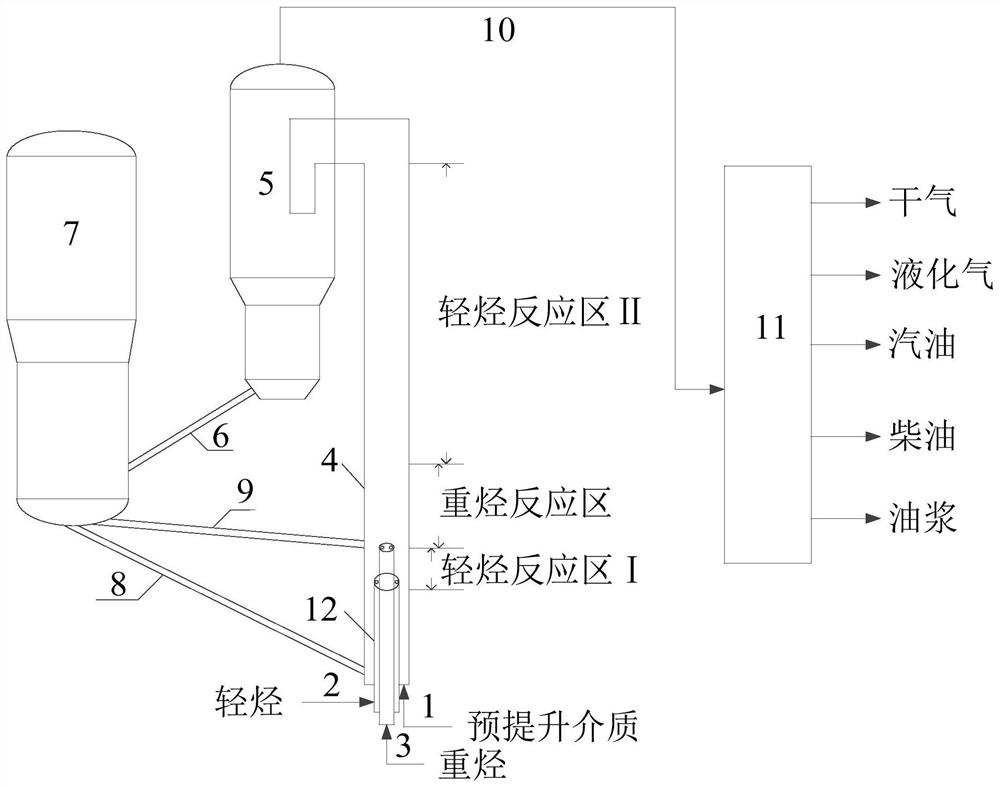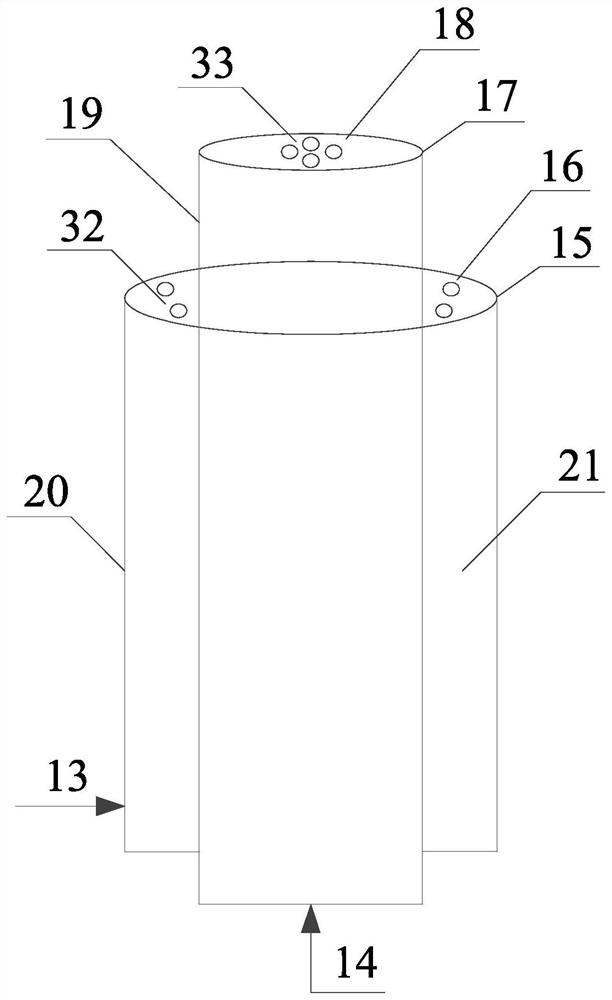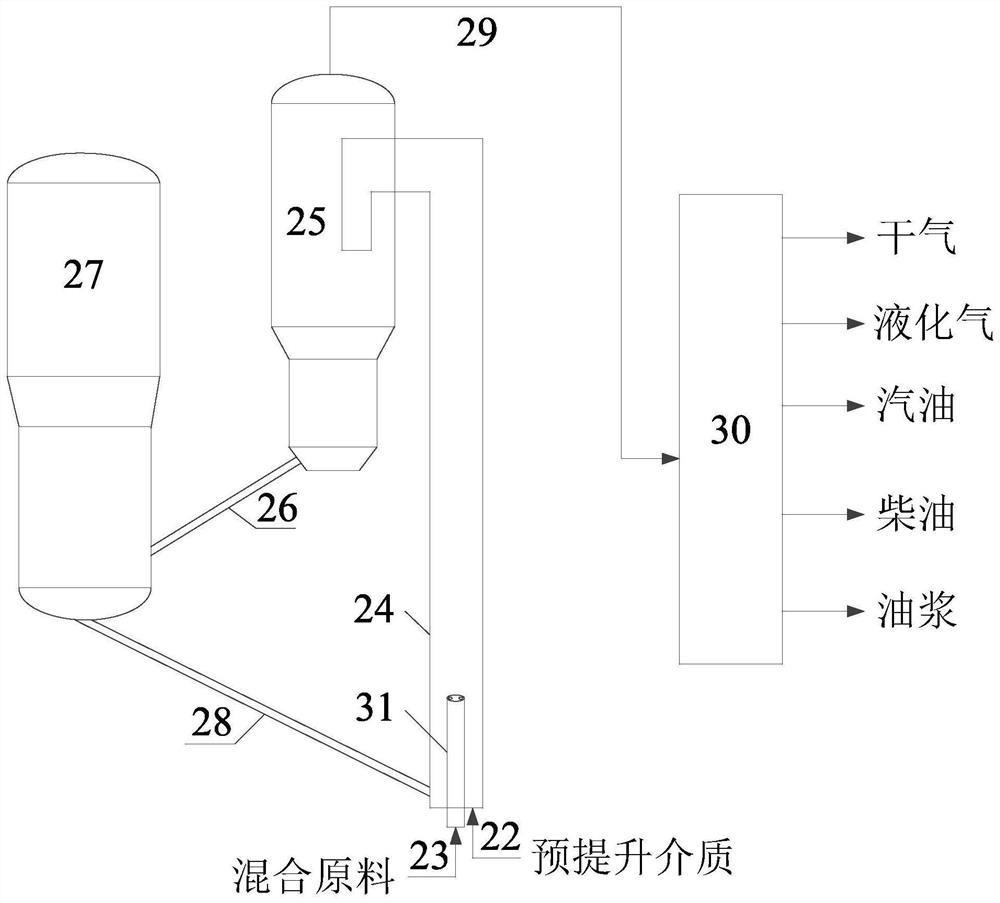A catalytic cracking conversion method for increasing gasoline production and reducing oil slurry
A catalytic cracking and oil slurry technology, applied in the field of hydrocarbon catalytic cracking conversion, can solve the problems of difficult implementation, complex process, low gasoline yield, etc., and achieve the effects of ensuring uniform contact, improving average activity, increasing gasoline production and reducing gasoline production.
- Summary
- Abstract
- Description
- Claims
- Application Information
AI Technical Summary
Problems solved by technology
Method used
Image
Examples
Embodiment 1
[0052] use figure 1 The device shown and figure 2 The one-piece nozzle shown was tested.
[0053] The heights of light hydrocarbon reaction zone I, heavy oil reaction zone and light hydrocarbon reaction zone II account for 5%, 35% and 55% of the total height of the riser reactor respectively. The ratio of the outer diameter of the light hydrocarbon casing 20 of the integrated nozzle 12 to the outer diameter of the heavy hydrocarbon outer casing 19 is 2.20:1, and the diameter of a single light hydrocarbon injection hole on the light hydrocarbon nozzle 16 is the same as that of the single heavy hydrocarbon nozzle 18 on the heavy hydrocarbon outer nozzle. The aperture ratio of the hydrocarbon outer injection holes is 1.429:1. The pre-lift medium was nitrogen.
[0054] Residue hydrogenated diesel oil with a mass flow rate of 150g / h is sprayed from 4 light hydrocarbon nozzles 32 on the light hydrocarbon nozzle 16 of the integrated nozzle 12, in the light hydrocarbon reaction zo...
Embodiment 2
[0062] use figure 1 The device shown and figure 2 The one-piece nozzle shown was tested.
[0063] The heights of light hydrocarbon reaction zone I, heavy oil reaction zone and light hydrocarbon reaction zone II account for 5%, 35% and 55% of the total height of the riser reactor respectively. The ratio of the outer diameter of the light hydrocarbon casing 20 of the integrated nozzle 12 to the outer diameter of the heavy hydrocarbon outer casing 19 is 2.20:1, and the diameter of a single light hydrocarbon injection hole on the light hydrocarbon nozzle 16 is the same as that of the single heavy hydrocarbon nozzle 18 on the heavy hydrocarbon outer nozzle. The aperture ratio of the hydrocarbon outer injection holes is 1.429:1. The pre-lift medium was nitrogen.
[0064] Residue hydrogenated diesel oil with a mass flow rate of 150g / h is sprayed from 4 light hydrocarbon nozzles 32 on the light hydrocarbon nozzle 16 of the integrated nozzle 12, in the light hydrocarbon reaction zo...
Embodiment 3
[0071] use figure 1 The device shown and figure 2 The one-piece nozzle shown was tested.
[0072] The heights of light hydrocarbon reaction zone I, heavy oil reaction zone and light hydrocarbon reaction zone II account for 5%, 35% and 55% of the total height of the riser reactor respectively. The ratio of the outer diameter of the light hydrocarbon casing 20 of the integrated nozzle 12 to the outer diameter of the heavy hydrocarbon outer casing 19 is 2.20:1, and the diameter of a single light hydrocarbon injection hole on the light hydrocarbon nozzle 16 is the same as that of the single heavy hydrocarbon nozzle 18 on the heavy hydrocarbon outer nozzle. The aperture ratio of the hydrocarbon outer injection holes is 1.429:1. The pre-lift medium was nitrogen.
[0073] Residue hydrogenated diesel oil with a mass flow rate of 150g / h is sprayed from 4 light hydrocarbon nozzles 32 on the light hydrocarbon nozzle 16 of the integrated nozzle 12, in the light hydrocarbon reaction zo...
PUM
 Login to View More
Login to View More Abstract
Description
Claims
Application Information
 Login to View More
Login to View More - R&D
- Intellectual Property
- Life Sciences
- Materials
- Tech Scout
- Unparalleled Data Quality
- Higher Quality Content
- 60% Fewer Hallucinations
Browse by: Latest US Patents, China's latest patents, Technical Efficacy Thesaurus, Application Domain, Technology Topic, Popular Technical Reports.
© 2025 PatSnap. All rights reserved.Legal|Privacy policy|Modern Slavery Act Transparency Statement|Sitemap|About US| Contact US: help@patsnap.com



